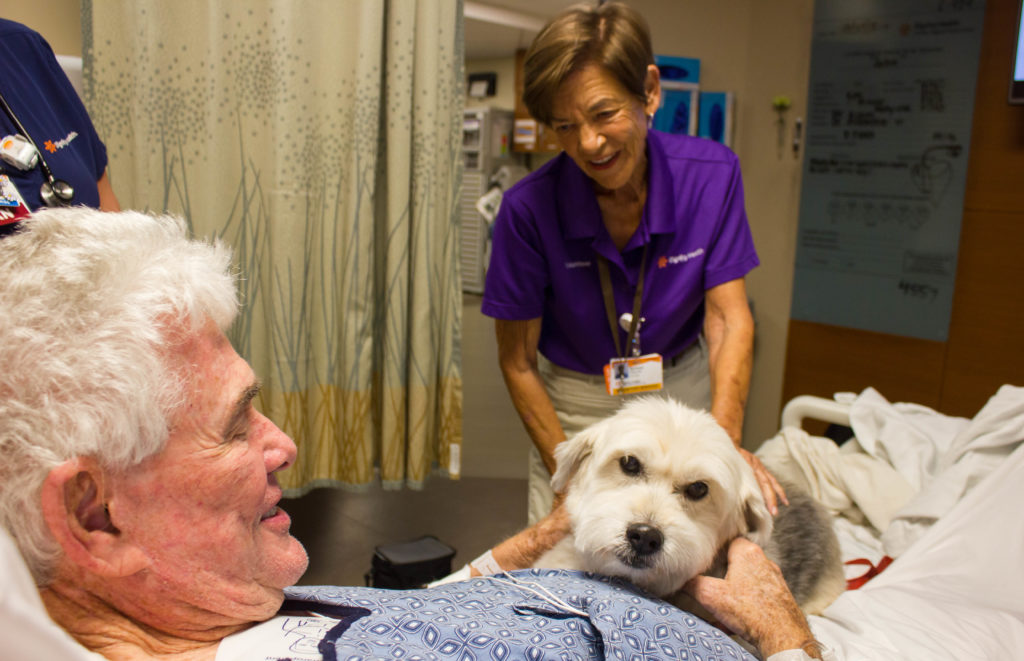
It’s not only the patients who love ’em; staff does too!
By Deborah Hilcove
Twice a week, 9-year-old Brandy 3.0 hops into the car with Barbara Warren and heads to Chandler Regional Medical Center where she immediately gets to work.
Her first stop with Warren is the waiting room where she greets friends and families of patients. Next, they take the elevator upstairs to visit patients, doctors, nurses and staff.
Brandy 3.0—third in a familial succession belonging to Warren—is a well-trimmed, fluffy mini- sheepdog working in the PAWs for Patients Therapy Program at CRMC. On a recent workday, one of her first patients was John Anderson, scheduled for surgery later in the day.
Anderson immediately welcomed Brandy and asked that she be put on the bed where he could easily pet her, scratch behind her ears and under her chin.
“I had a Brittany spaniel for 17 years and miss having a dog,” he says. Anderson adjusts himself against the pillows before continuing. “There’s anxiety when you’re waiting for
tests and for surgery. The dogs are a calming presence. When there’s complicated surgery, the dogs bring you back to reality—not the hospital reality, where anticipation plays on your imagination, but a sense of comfort and peace.”
His statements coincide with research that shows interacting with an animal influences the hormones associated with blood pressure regulation, pain and stress relief—and joy. It can help distract patients from pain, nurturing a sense of well-being.
Brandy 3.0 and Warren say goodbye for now to Anderson and step across the hall, where several nurses gather to pet and talk to Brandy. Asked about the PAWs program, Stephanie Crandall, an R.N. with two rescue dogs of her own, says, “I love it.”
A four-year veteran at CRMC, Crandall appreciates “the attention focused outside traditional medicine, so it’s not just vital signs and medications, but the whole person is treated.”
She adds, “We all like for the dogs to visit. It’s therapy for us, too. A lot of people don’t realize the stress of nurses. There’s so much coming at you all day long. Every discipline, every area—labs, test results, doctors’ orders, family inquiries, patient requests—they’re all funneled through you. It can get overwhelming. The dogs help calm us, too.” Warren agrees, waves to a passing staffer.
When asked how she came to volunteer with Brandy 3.0 at the hospital, Warren admits she had no plans to do so—that is, until she became a patient at Chandler Regional.
“Everyone was so kind. They were all busy, but they made me feel like their only patient. I’d been volunteering somewhere else, but it wasn’t the best fit. They asked me to try it here, and Brandy and I’ve been here ever since.”
Another therapy dog—a large black Bouvier des Flandres named Vespa— approaches with his handler, Rick Ellis.
They stand near the door to Anderson’s room while Ellis introduces Vespa and asks Anderson if they may visit. Anderson pats the side of his bed and calls Vespa. The big dog gently places his front paws where Anderson has indicated and leans forward, inviting an ear-scratch.
“He must have eyes in there somewhere,” Anderson says, and laughs as he strokes Vespa’s forehead, smoothing the long curly hair hiding his eyes.
Ellis laughs, too, and shares a story about Vespa’s birthday. “He just turned five in October. He got a card from the hospital staff—and a cheeseburger.”
Wrangler News photographer Alex Walker steps into the hall to tell about his own experience.
Critically injured in a motorcycle accident nearly 18 months ago, Walker spent three weeks in the hospital with eight broken bones, collapsed lungs, a concussion and pneumonia, followed by a week in rehab-therapy.
Says Walker:
“The dogs were amazing. I remember the day they first came in ’cause that particular day was a rough one (lots of testing, feeling lonely) and when they came in the room, it lit right up, and I forgot about everything else for that moment.
I remember a small Shih Tzu that just cuddled his head into my arms and lay there with me as long as I wanted him to. It was unconditional affection.”
Volunteer Services Supervisor Lori Mercer says the dogs (on a lead during visits) must have basic obedience skills, current vac- cinations and be bathed within 24 hours of visitations. Stringent infection-control standards must be met by the team.
She notes that the hospital’s program “began in 2006 with four dogs.” Its popularity has grown, and the program is now the largest dog therapy program in the East Valley, she says, with 25 therapy dogs that “average 2,300 inpatient visits per month.”
She adds, “We are always recruiting and have a few more teams on the way.”
The therapeutic teams are trained and registered by Pet Partners, an international organization advocating that “animals can influence not just our happiness, but also our health.”
This credo mirrors the commitment of Dignity Health to “Humankindness,” healing through medicine, coupled with compassion.
Information:
• dignityhealth.org/arizona
• dignityhealthphilanthropy.org/what-we-support/canine-kindness

